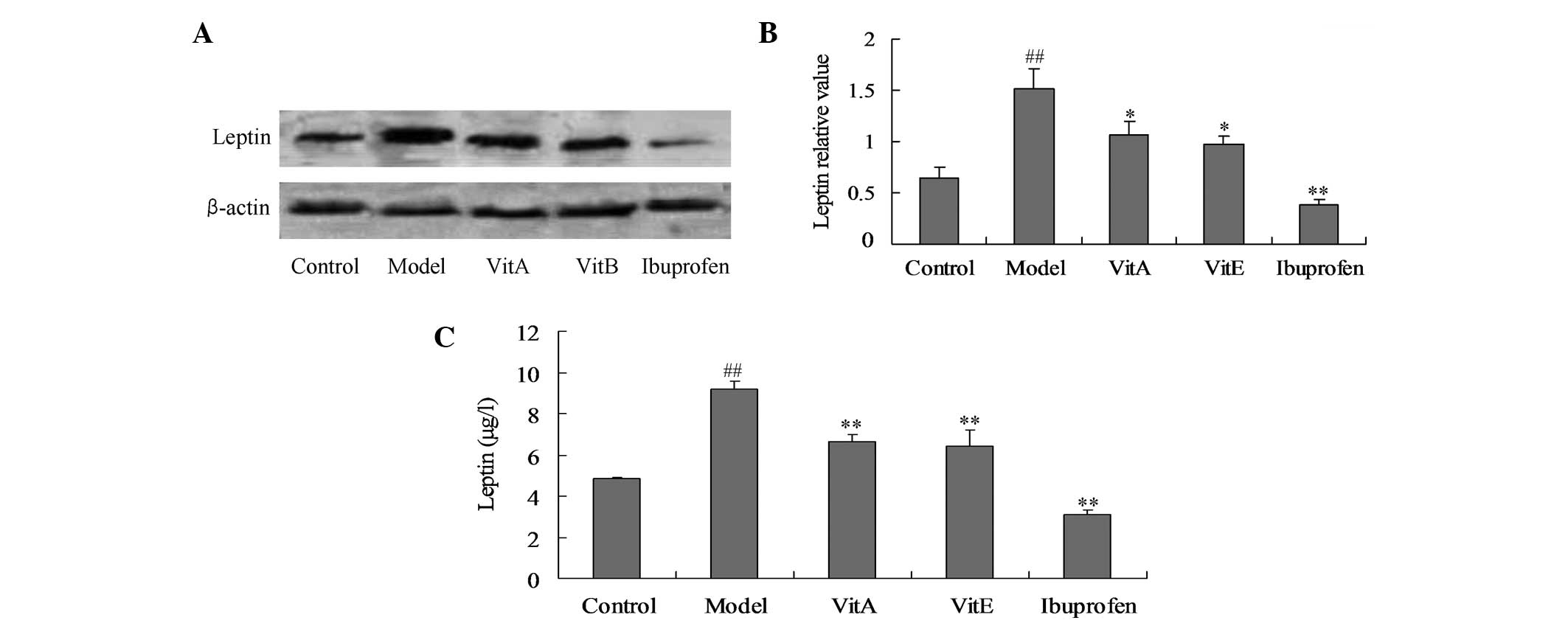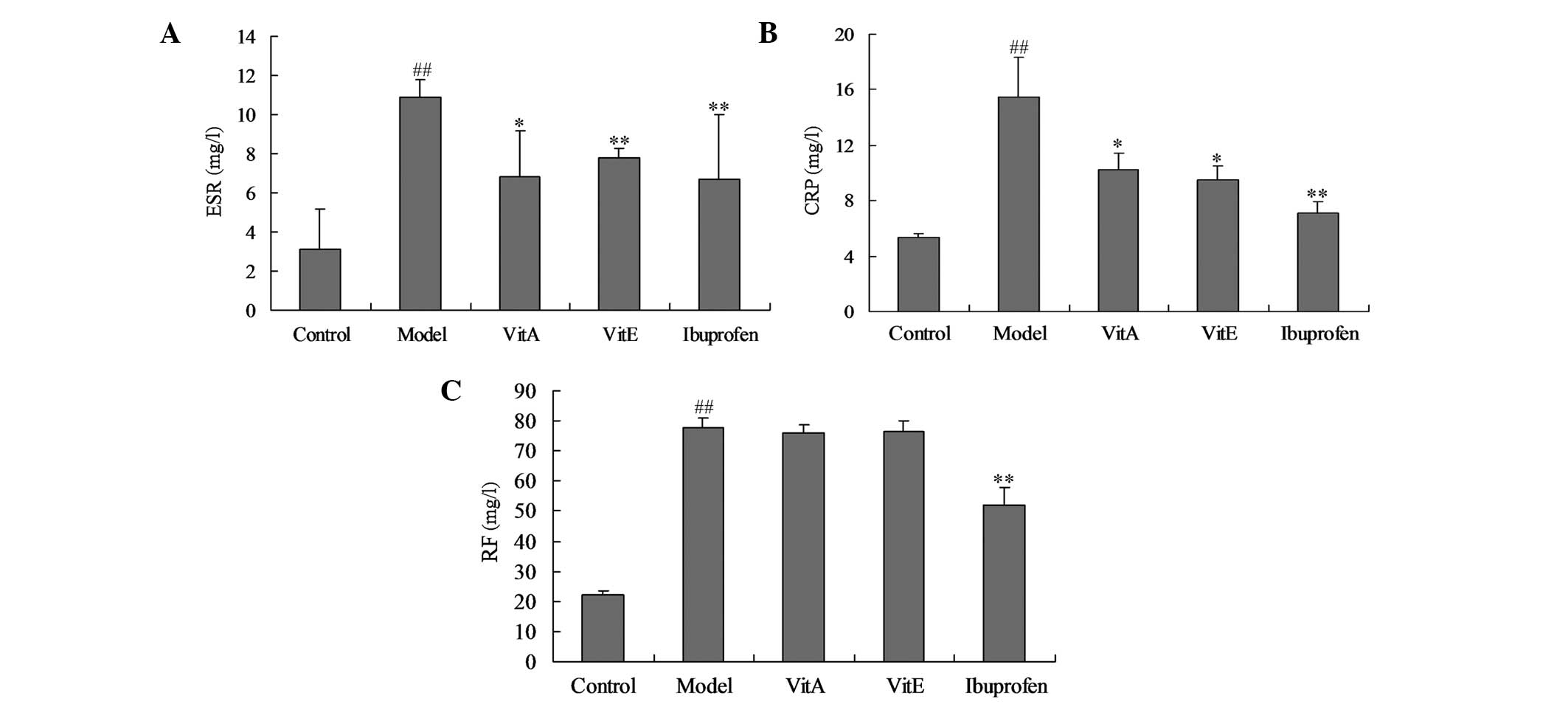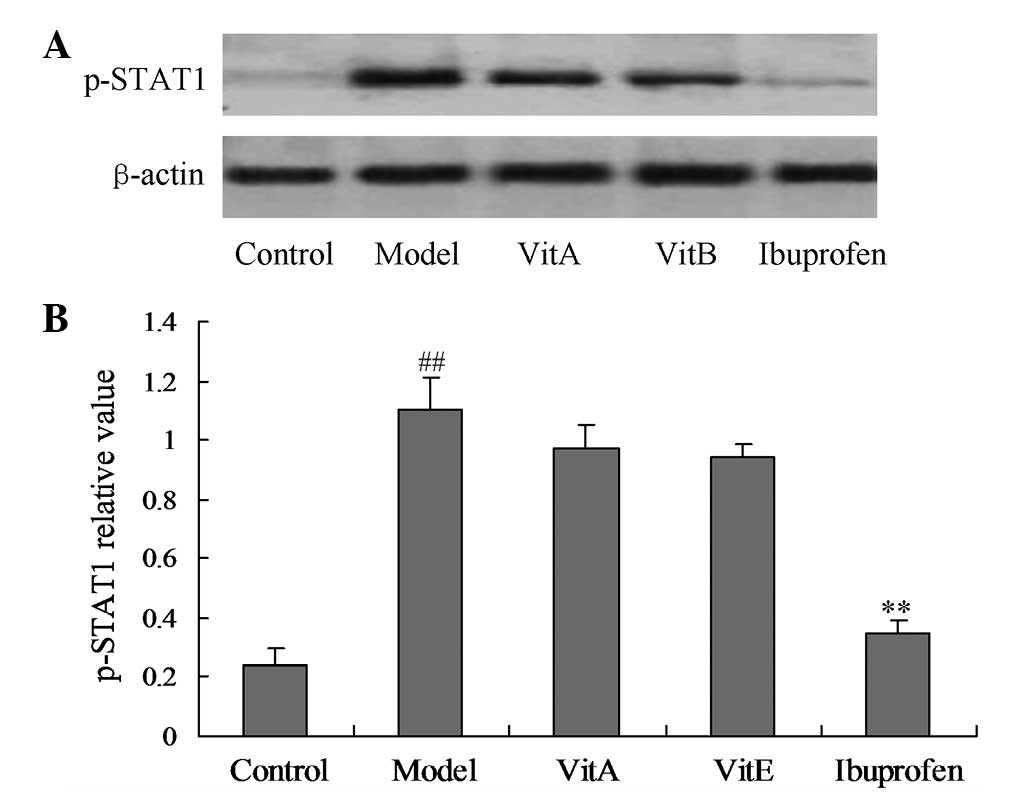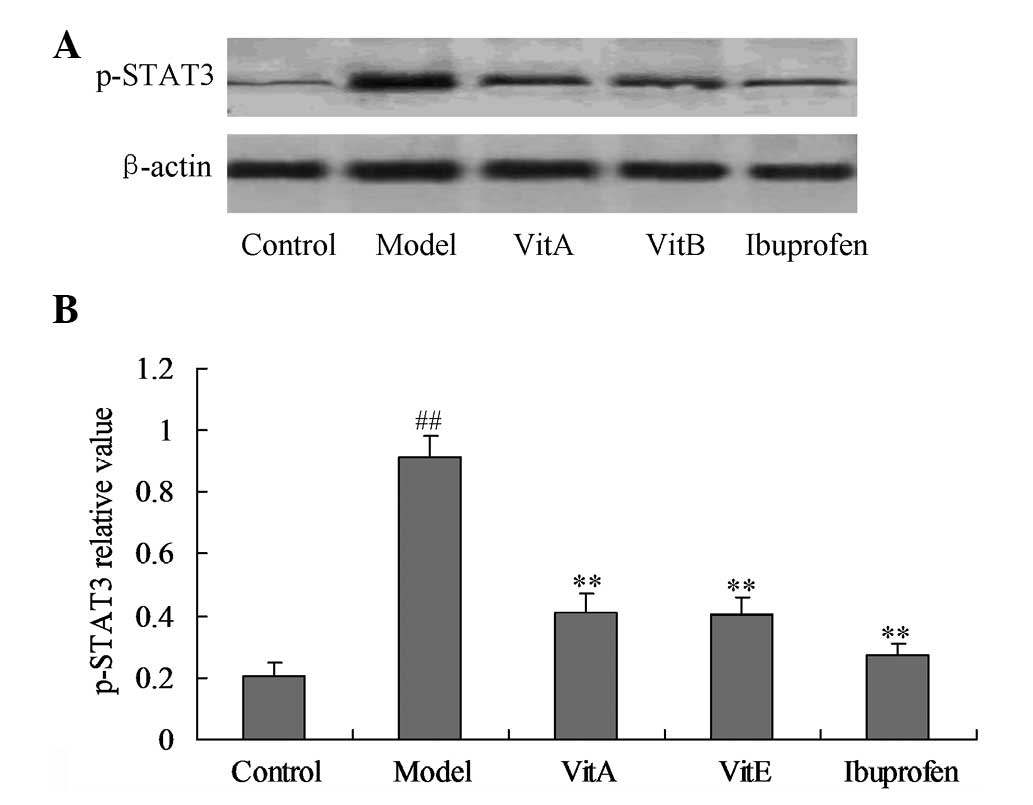|
1
|
Li WH, Li H, Song WQ, Hu YL, Liu YH, Da R,
Chen XB, Li Y, Ling H, Zhong ZH and Zhang FM: Differential
diagnosis of systemic lupus erythematosus and rheumatoid arthritis
with complements C3 and C4 and C-reactive protein. Exp Ther Med.
6:1271–1276. 2013.PubMed/NCBI
|
|
2
|
Gaston JS: Cytokines in arthritis - the
‘big numbers’ move centre stage. Rheumatology (Oxford).
47:8–12. 2008.
|
|
3
|
Maffei M, Halaas J, Ravussin E, Pratley
RE, Lee GH, Zhang Y, Fei H, Kim S, Lallone R, Ranganathan S, et al:
Leptin levels in human and rodent: measurement of plasma leptin and
ob RNA in obese and weight-reduced subjects. Nat Med. 1:1155–1161.
1995. View Article : Google Scholar : PubMed/NCBI
|
|
4
|
Sagiroglu T, Torun N, Yagci M, Yalta T,
Sagiroglu G and Oguz S: Effects of apelin and leptin on renal
functions following renal ischemia/reperfusion: An experimental
study. Exp Ther Med. 3:908–914. 2012.PubMed/NCBI
|
|
5
|
Bokarewa M, Bokarew D, Hultgren O and
Tarkowski A: Leptin consumption in the inflamed joints of patients
with rheumatoid arthritis. Ann Rheum Dis. 62:952–956. 2003.
View Article : Google Scholar : PubMed/NCBI
|
|
6
|
Lane ML and Vesely DL: Reduction of leptin
levels by four cardiac hormones: Implications for hypertension in
obesity. Exp Ther Med. 6:611–615. 2013.PubMed/NCBI
|
|
7
|
Bates SH, Stearns WH, Dundon TA, Schubert
M, Tso AW, Wang Y, Banks AS, Lavery HJ, Hag AK, Maratos-Flier E,
Neel BG, Schwartz MW and Myers MG Jr: STAT3 signalling is required
for leptin regulation of energy balance but not reproduction.
Nature. 421:856–859. 2003. View Article : Google Scholar : PubMed/NCBI
|
|
8
|
Smolen JS, Landew R, Breedveld FC, et al:
EULAR recommendations for the management of rheumatoid arthritis
with synthetic and biological disease-modifying antirheumatic
drugs. Ann Rheum Dis. 69:964–975. 2010. View Article : Google Scholar
|
|
9
|
Martin RH: The role of nutrition and diet
in rheumatoid arthritis. Proc Nutr Soc. 57:231–234. 1998.
View Article : Google Scholar : PubMed/NCBI
|
|
10
|
Salminen E, Heikkilä S, Poussa T, Lagström
H, Saario R and Salminen S: Female patients tend to alter their
diet following the diagnosis of rheumatoid arthritis and breast
cancer. Prev Med. 34:529–535. 2002. View Article : Google Scholar : PubMed/NCBI
|
|
11
|
Stone J, Doube A, Dudson D and Wallace J:
Inadequate calcium, folic acid, vitamin E, zinc, and selenium
intake in rheumatoid arthritis patients: results of a dietary
survey. Semin Arthritis Rheum. 27:180–185. 1997. View Article : Google Scholar : PubMed/NCBI
|
|
12
|
Canter PH, Wilder B and Emst E: The
antioxidant vitamins A, C, E and selenium in the treatment of
arthritis: a systematic review of randomized clinical trials.
Rheumatology (Oxford). 46:1223–1233. 2007. View Article : Google Scholar : PubMed/NCBI
|
|
13
|
Doe JE, Lewis RW and Botham PA: Comments
on a scientific and animal welfare assessment of the OECD Health
Effects Test Guidelines for the safety testing of chemicals under
the European Union REACH system. Altern Lab Anim. 34:111–114.
2006.
|
|
14
|
Tanaka D, Kagari T, Doi H and Shimozato T:
Essential role of neutrophils in anti-type II collagen antibody and
lipopolysaccharide-induced arthritis. Immunology. 119:195–202.
2006. View Article : Google Scholar : PubMed/NCBI
|
|
15
|
McInnes IB and Schett G: Cytokines in the
pathogenesis of rheumatoid arthritis. Nat Rev Immunol. 7:429–442.
2007. View
Article : Google Scholar : PubMed/NCBI
|
|
16
|
Kuroyanagi G, Yamada K, Imaizumi T,
Mizutani J, Wada I, Kozawa O, Tokuda H and Otsuka T: Leg lymphedema
caused by iliopectineal bursitis associated with destruction of a
rheumatoid hip joint: A case report. Exp Ther Med. 6:887–890.
2013.PubMed/NCBI
|
|
17
|
Wirjatijasa F, Dehghani F, Blaheta RA,
Korf HW and Hailer NP: Interleukin-4, interleukin-10, and
interleukin-1-receptor antagonist but not transforming growth
factor-beta induce ramification and reduce adhesion molecule
expression of rat microglial cells. J Neurosci Res. 68:579–587.
2002. View Article : Google Scholar
|
|
18
|
Martín-Romero C, Santos-Alvarez J, Goberna
R and Sanchez-Margalet V: Human 1eptin enhances activation and
proliferation of human circulation T 1ymphocytes. Cell Immunol.
199:15–24. 2000.PubMed/NCBI
|
|
19
|
Hagfors L, Leanderson P, Sköldstam L,
Andersson J and Johansson G: Antioxidant intake, plasma
antioxidants and oxidative stress in a randomized, controlled,
parallel, Mediterranean dietary intervention study on patients with
rheumatoid arthritis. Nutr J. 2:52003. View Article : Google Scholar
|
|
20
|
Wang Z, Chen Z, Yang S, Wang Y, Yu L,
Zhang B, Rao Z, Gao J and Tu S: (1)H NMR-based metabolomic analysis
for identifying serum biomarkers to evaluate methotrexate treatment
in patients with early rheumatoid arthritis. Exp Ther Med.
4:165–171. 2012.
|
|
21
|
Bae SC, Kim SJ and Sung MK: Inadequate
antioxidant nutrient intake and altered plasma antioxidant status
of rheumatoid arthritis patients. J Am Coll Nutr. 22:311–315. 2003.
View Article : Google Scholar : PubMed/NCBI
|
|
22
|
Edmonds SE, Winyard PG, Guo R, Kidd B,
Merry P, Langrish-Smith A, Hansen C, Ramm S and Blake DR: Putative
analgesic activity of repeated oral doses of vitamin E in the
treatment of rheumatoid arthritis. Results of a prospective placebo
controlled double blind trial. Ann Rheum Dis. 56:649–655. 1997.
View Article : Google Scholar
|
|
23
|
Wittenborg A, Petersen G, Lorkowski G and
Brabant T: Effectiveness of vitamin E in comparison with diclofenac
sodium in treatment of patients with chronic polyarthritis. Z
Rheumatol. 57:215–221. 1998.(In German).
|
|
24
|
Sakai A, Hirano T, Okazaki R, Okimoto N,
Tanaka K and Nakamura T: Large dose ascorbic acid administration
suppresses the development of arthritis in adjuvant-injected rats.
Arch Orthop Trauma Surg. 119:121–126. 1999. View Article : Google Scholar : PubMed/NCBI
|
|
25
|
Piva E, Fassina P and Plebani M:
Determination of the length of sedimentation reaction (erythrocyte
sedimentation rate) in non-anticoagulated blood with the Microtest
1. Clin Chem Lab Med. 40:713–717. 2002. View Article : Google Scholar : PubMed/NCBI
|
|
26
|
Du Clos TW and Mold S: The role of C
reactive protein in the resolution of bacterial infection. Curr
Opin Infect Dis. 14:289–293. 2001.PubMed/NCBI
|
|
27
|
Erlandsen EJ and Randers E: Reference
interval for serum C-reactive protein in healthy blood donors using
the Dade Behring N Latex CRP mono assay. Scand J Clin Lab Invest.
60:37–43. 2000. View Article : Google Scholar : PubMed/NCBI
|
|
28
|
van der Pouw Kraan TC, van Gaalen FA,
Kasperkovite PV, et al: Rheumatoid arthritis is a heterogeneous
disease: evidence for differences in the activation of the STAT-1
pathway between rheumatoid tissues. Arthritis Rheum. 48:2132–2145.
2003.PubMed/NCBI
|
|
29
|
Krause A, Scaletta N, Ji JD and Ivashkiv
LB: Rheumatoid arthritis synoviocyte survival is dependent on
Stat3. J Immunol. 169:6610–6616. 2002. View Article : Google Scholar : PubMed/NCBI
|
|
30
|
Nak SS, Lee S, Joo J, Kim HK, Sohn DR,
Kwon JT, Woo KM, Hong SJ and Kim HJ: Association of ADAMTS12
polymorphisms with rheumatoid arthritis. Mol Med Rep. 6:227–231.
2012.PubMed/NCBI
|


















